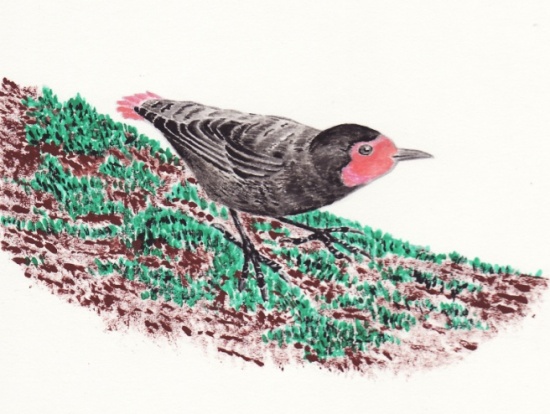(Taxonomy expanded. References) |
|||
| Line 13: | Line 13: | ||
====Subspecies<sup>[[#References|[1]]]</sup>==== | ====Subspecies<sup>[[#References|[1]]]</sup>==== | ||
This species has three subspecies: | This species has three subspecies: | ||
| − | *'' | + | *''D. m. frontalis'': |
:*Mountains of north-western [[New Guinea]] | :*Mountains of north-western [[New Guinea]] | ||
| − | *'' | + | *''D. m. kuboriensis'': |
:*Central Highlands of north-eeastern [[New Guinea]] | :*Central Highlands of north-eeastern [[New Guinea]] | ||
| − | *'' | + | *''D. m. miranda'': |
:*Mountains of south-eastern [[New Guinea]] | :*Mountains of south-eastern [[New Guinea]] | ||
| + | |||
==Habitat== | ==Habitat== | ||
Highlands and dense rainforests. | Highlands and dense rainforests. | ||
Revision as of 06:06, 26 November 2009

Artwork by bru.b
- Daphoenositta miranda
Identification
14cm
- Mostly black
- Red face
- Dagger shaped bill
- Short tail
Distribution
Taxonomy
Some authorities list this species in the genus Neositta; if so the scientific name would be Neositta miranda.
Subspecies[1]
This species has three subspecies:
- D. m. frontalis:
- Mountains of north-western New Guinea
- D. m. kuboriensis:
- Central Highlands of north-eeastern New Guinea
- D. m. miranda:
- Mountains of south-eastern New Guinea
Habitat
Highlands and dense rainforests.
Behaviour
Breeding
Nests are open cups in forked branches. The 2-3 eggs are incubated by the female for 19-20 days.
Diet
The diet includes insects, spiders and caterpillars.
References
- Clements, JF. 2008. The Clements Checklist of Birds of the World. 6th ed., with updates to December 2008. Ithaca: Cornell Univ. Press. ISBN 978-0801445019.
- Wikipedia
Recommended Citation
- BirdForum Opus contributors. (2025) Black Sittella. In: BirdForum, the forum for wild birds and birding. Retrieved 5 February 2025 from https://www.birdforum.net/opus/Black_Sittella



